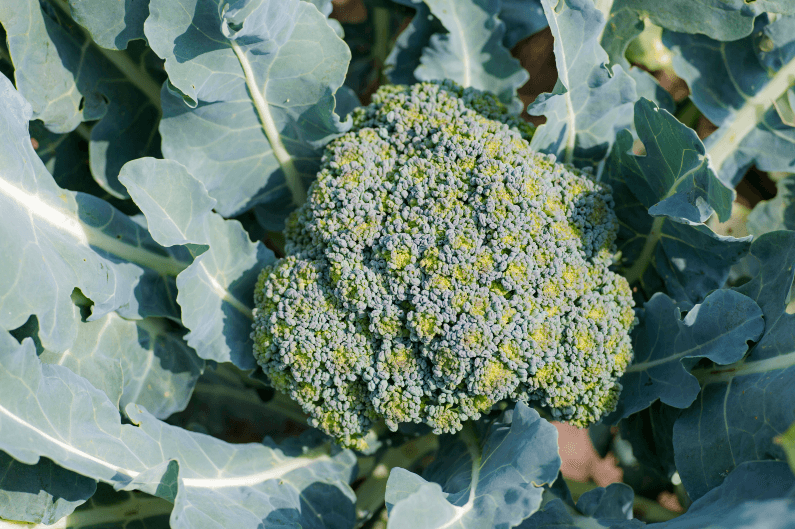Let’s look how to grow broccoli plants in Texas! The most important trait about broccoli is to remember it likes cool temperatures and fertile soil. Many Texans remember, President George H.W. Bush’s disdain for broccoli, but I think he just did not realize how healthy broccoli was or else it would’ve been on his plate every single night. Did you know broccoli has more vitamin C than an orange? Plus broccoli is rich in calcium, magnesium, vitamin K, fiber and other antioxidants. All the more reason to grow broccoli in your Texas garden!

Table of Contents
When to Plant Broccoli in Texas
Broccoli is a cool season crop and will bolt, or flower, when the weather is too hot. Broccoli is able to tolerate light frost, but not hard freezes.
Broccoli grows best when transitioned out into the garden as transplants. Start your broccoli seeds in your seed starting trays in late summer for a fall crop and early spring for a spring crop. You will transplant the broccoli into the garden when the plants are 4 – 6 weeks old with at least one set of true leaves.
In northern Texas, you can generally plant your fall crop toward the end of September and in October for southern Texas. For spring planting, set out your broccoli transplants in the first week of February for southern Texas and around mid-February for northern Texas.
Where to Plant Broccoli
Choose a sunny area of your garden to plant your broccoli as it requires at least 8 hours of direct sunlight to produce an healthy broccoli heads. You can also grow broccoli in a container, plant one plant per 12″ diameter container and place it in a sunny area.
Amend your soil with several inches of organic matter, such as mushroom compost, and incorporate well into your soil Prior to planting, about 2 lbs of a complete balanced fertilizer to every 35 row feet. If you’re planting in a container or small area, apply 2 teaspoons of the fertilizer per container or square foot and blend it into the soil well.
You can use a simple meter to soil test the pH of your planting area. Broccoli will grow best in soil pH that is between 6.0 and 7.0.
Broccoli is an excellent companion plant to spinach so consider planting spinach as a companion plant next to a row of broccoli.
How to Plant Broccoli in the Garden

Broccoli is most always transplanted into the garden. If you do not grow your own transplants, broccoli starts are easy to find at your local garden nursery.
Plant transplants 12 – 18″ apart in loose, rich soil. Dig holes that are the same depth as the container in which the broccoli is growing. Carefully remove the transplant from the pot, lightly loosen any tangled roots and place the transplant in the hole. Firm the soil around the transplant and water them thoroughly. It is best to transplant in the late afternoon hours to minimize transplant shock.
Tips for Watering & Fertilizing Broccoli Plants
The two main keys to growing a successful broccoli crop are water and fertility. Always keep your soil moist. Broccoli grows best when watered at the base of the plan via drop irrigation, soaker hoses or hand watering.
Two weeks after transplanting side dress each 35′ of row with 1/2 cup of high nitrogen fertilizer. Lightly work work the fertilizer into the soil and water well. Once the main head of broccoli starts to form side dress with 1 cup of of high nitrogen fertilizer and work it into the soil, watering well. After harvesting the main dark green heads of broccoli, fertilize again with one more cup on high nitrogen fertilizer to encourage the production of side shoots.
How to Protect Broccoli from Freeze?
Broccoli can withstand some cold weather down to 26°F before protection is needed from freezing temperatures. If lower temperatures are forecasted, a floating row cover and protect the leaves and plant from cooler temperatures to extend your growing season.
When and How to Harvest Broccoli

Broccoli is generally ready to harvest 60 – 80 days after transplanting depending upon the variety. When the heads are compact and approximately 6 – 8 inches in diameter it is harvest time. Using a sharp knife, cut the stem 6 – 8 inches below the head. You will notice after harvesting the main head of broccoli, smaller heads and side shoots will begin to form. They are excellent bite size pieces perfect for snacking, salads and stir fry.
If the weather starts to warm before your spring harvest, you’ll notice flower buds forming. Be sure to harvest the main head of broccoli before these yellow flowers begin to open. At this point you will harvest your broccoli head regardless of size. When broccoli flowers, it is called bolting. Bolted broccoli is bitter and no longer tender.
Common Broccoli Pests & Diseases
Cabbage Worms & Cabbage Loopers
These larvae can quickly cause damage to any cole crops, but they can be controlled easily through several organic methods:
Organic Ways to Control Broccoli Pests:
- Bacillus Thuringiensis, commonly referred to at BT, can be sprayed on the top side and underside of the broccoli leaves to treat a wide arrange of catepillars destroying the foliage of the broccoli plants
- Food grade diatomaceous earth can be sprinkled all over the leaves and surrounding area of the broccoli plants. The crushed up crustacean shells making up the diatemeous earth will cut and dehydrate the caterpillars plaguing your garden.
- Beneficial insects such as parasitic wasps and lady bugs. Using beneficial insects as pests control takes time to work. It’s best to have release these insects in your garden before harmful pests become a problem.
Harlequin Bugs
Another common pests among broccoli and other members of the brassica family are harlequin bugs. These bugs can be removed by removing them by hand or spraying with spinosad.
Broccoli Diseases
While rare, broccoli can suffer from fungal disease such as downy mildew and black rot. The best method is prevention by making sure your broccoli seedlings are planted 12″ apart to ensure good air circulation between mature plants and always water at the base of the plant. Of course if you’re in a humid, rainy environment you might have to treat these diseases. Spraying an organic copper fungicide weekly can keep these diseases at bay and contribute to a successful broccoli harvest.
As with other crops rotating your crops will greatly help to reduce pests and disease pressure. Plant broccoli where non-brassica plants have been growing for the previous 2 – 3 growing season for best results.
Favorite Varieties of Broccoli to Grow Texas
Some favorite varieties that do well in a Texas vegetable garden are:
- Green Magic – A heat tolerant, hybrid, broccoli variety that does well in Texas is Green Magic. This broccoli producers uniform large heads of broccoli about 55 days days after transplanting.
- Packman – Another hybrid variety that is excellent for for many gardeners and climates. This is an early producing variety and produces heavy yields. After you harvest the main head, many side shoots will grow offering continual harvest opportunities.
- Imperial – Warm climate gardeners also have excellent results with Imperial broccoli. As a hybrid it is bred with a heat tolerance to handle the longer days and warmer temperatures of an early fall or late spring planting. This is definitely one to try!


